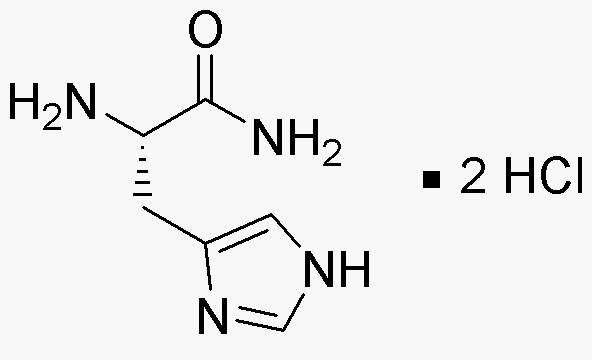L-Histidine amide dihydrochloride is widely utilized in research focused on:
- Biochemical Research: It serves as a building block for synthesizing peptides and proteins, which are essential for studying enzyme functions and cellular processes.
- Pharmaceutical Development: This compound is explored for its potential therapeutic effects, particularly in formulations aimed at treating conditions like anemia and neurodegenerative diseases.
- Nutrition and Dietary Supplements: It is used in formulations to enhance amino acid profiles in supplements, supporting muscle recovery and overall health.
- Cell Culture Media: L-Histidine amide dihydrochloride is incorporated into cell culture media to promote optimal growth conditions for various cell types, aiding in research and development.
- Analytical Chemistry: It is utilized as a standard in chromatographic techniques, helping researchers to accurately quantify histidine-related compounds in biological samples.
General Information
Properties
Safety and Regulations
Applications
L-Histidine amide dihydrochloride is widely utilized in research focused on:
- Biochemical Research: It serves as a building block for synthesizing peptides and proteins, which are essential for studying enzyme functions and cellular processes.
- Pharmaceutical Development: This compound is explored for its potential therapeutic effects, particularly in formulations aimed at treating conditions like anemia and neurodegenerative diseases.
- Nutrition and Dietary Supplements: It is used in formulations to enhance amino acid profiles in supplements, supporting muscle recovery and overall health.
- Cell Culture Media: L-Histidine amide dihydrochloride is incorporated into cell culture media to promote optimal growth conditions for various cell types, aiding in research and development.
- Analytical Chemistry: It is utilized as a standard in chromatographic techniques, helping researchers to accurately quantify histidine-related compounds in biological samples.
Documents
Safety Data Sheets (SDS)
The SDS provides comprehensive safety information on handling, storage, and disposal of the product.
Product Specification (PS)
The PS provides a comprehensive breakdown of the product’s properties, including chemical composition, physical state, purity, and storage requirements. It also details acceptable quality ranges and the product's intended applications.
Certificates of Analysis (COA)
Search for Certificates of Analysis (COA) by entering the products Lot Number. Lot and Batch Numbers can be found on a product’s label following the words ‘Lot’ or ‘Batch’.
*Catalog Number
*Lot Number
Certificates Of Origin (COO)
This COO confirms the country where the product was manufactured, and also details the materials and components used in it and whether it is derived from natural, synthetic, or other specific sources. This certificate may be required for customs, trade, and regulatory compliance.
*Catalog Number
*Lot Number
Safety Data Sheets (SDS)
The SDS provides comprehensive safety information on handling, storage, and disposal of the product.
DownloadProduct Specification (PS)
The PS provides a comprehensive breakdown of the product’s properties, including chemical composition, physical state, purity, and storage requirements. It also details acceptable quality ranges and the product's intended applications.
DownloadCertificates of Analysis (COA)
Search for Certificates of Analysis (COA) by entering the products Lot Number. Lot and Batch Numbers can be found on a product’s label following the words ‘Lot’ or ‘Batch’.
*Catalog Number
*Lot Number
Certificates Of Origin (COO)
This COO confirms the country where the product was manufactured, and also details the materials and components used in it and whether it is derived from natural, synthetic, or other specific sources. This certificate may be required for customs, trade, and regulatory compliance.


